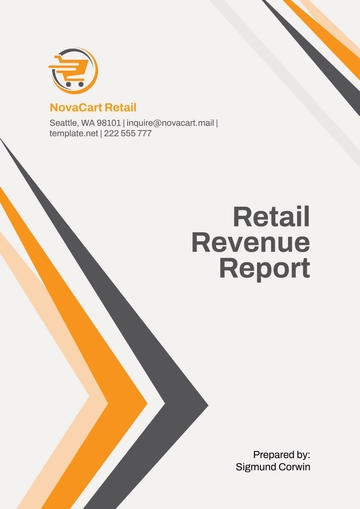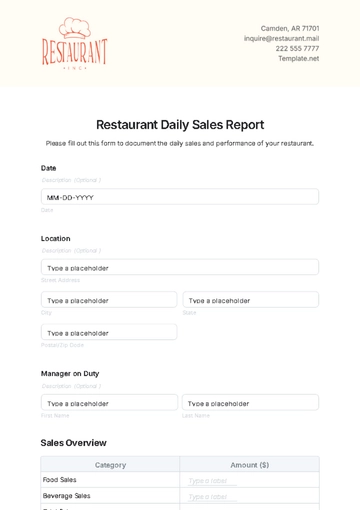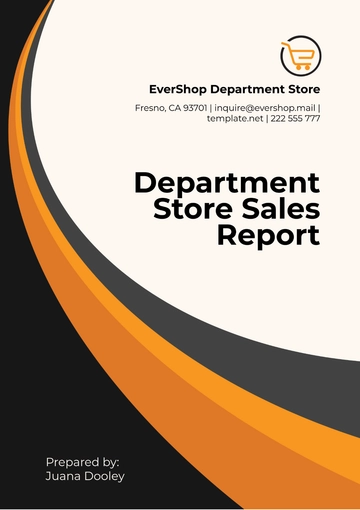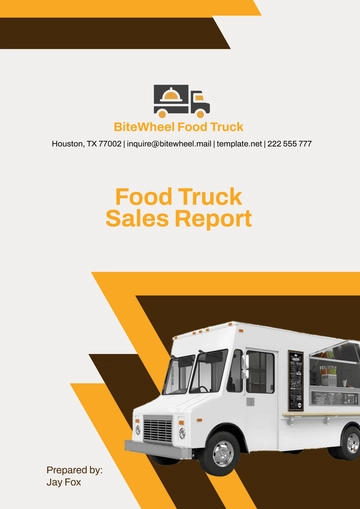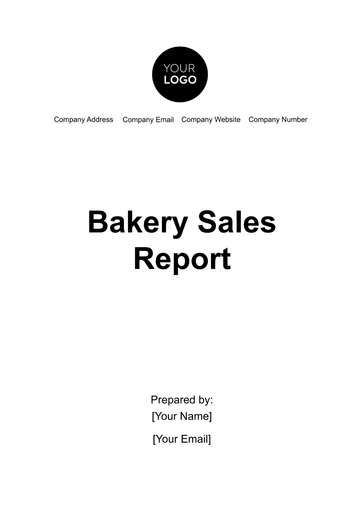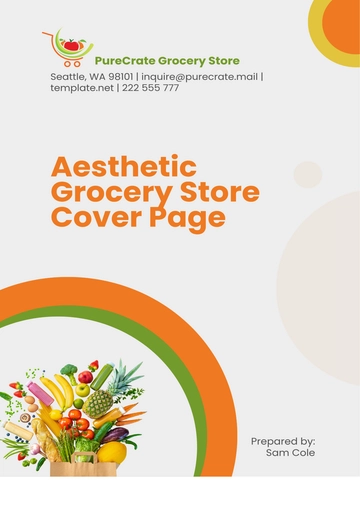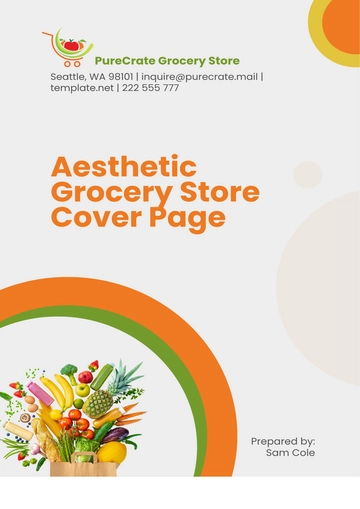Free Grocery Store Report

I. Executive Summary
A. Overview of Store Performance
The grocery store experienced significant growth this quarter, with a [00]% increase in total sales compared to the previous quarter. Enhanced customer service initiatives contributed to a notable rise in customer satisfaction ratings. The introduction of new product lines, particularly in the organic and health food segments, has been well-received by the community.
B. Key Highlights and Achievements
Key achievements include the successful launch of an online ordering system, expanding the organic product range by [00]%, and executing a highly successful holiday promotion campaign that boosted December sales by [00]%. Additionally, the store received a community service award for its contributions to local food drives.
C. Major Challenges and Solutions
The main challenges faced were supply chain disruptions and staffing shortages. To address these, we diversified suppliers to ensure a steady flow of products and introduced flexible work schedules and retention bonuses to attract and retain employees. Implementing an employee referral program also helped mitigate staffing issues.
D. Objectives and Goals for the Next Period
Goals for the next period include increasing market share by [00]%, enhancing the online shopping experience with a mobile app, and achieving a [00]% reduction in operational costs through process optimization and energy-saving measures. We also aim to introduce a loyalty rewards program to further boost customer retention.
II. Sales Performance
A. Total Sales Overview
Monthly Sales Breakdown
Month | Sales | Growth Rate |
|---|---|---|
January | $[00] | [00]% |
February | $[00] | [00]% |
March | $[00] | [00]% |
Year-over-Year Comparison
Total sales for this quarter were $[00] million, up from $[00] million in the same quarter last year, marking a [00]% increase. This growth is attributed to enhanced product offerings and effective marketing strategies.
B. Sales by Category
Fresh Produce
Fresh produce sales increased by [00]%, driven by the introduction of locally sourced fruits and vegetables and improved product display techniques. The "Farmer's Market Fridays" initiative also attracted more customers to this category.
Dairy and Frozen Foods
Dairy and frozen foods saw a [00]% growth, with premium ice cream and specialty cheeses being top sellers. The expansion of our dairy-free and lactose-free options also contributed to this increase.
Packaged Goods
Packaged goods remained stable with a slight [00]% increase, maintaining a strong customer base for pantry staples. The introduction of new international food products added diversity to our offerings.
Beverages
Beverage sales surged by [00]%, particularly in the organic juice and craft beer segments. The introduction of a "Build Your Own Six-Pack" promotion for craft beers was especially popular.
Household Items
Household items experienced a [00]% growth, with cleaning supplies and paper products being in high demand due to continued health and hygiene concerns. Eco-friendly product lines also saw increased interest.
C. Sales Trends
Seasonal Variations
Sales peaked during the holiday season, with December showing a [00]% increase compared to the monthly average. Back-to-school promotions in late summer also contributed to higher sales in August and September.
Top-Selling Products
Top-selling products included organic apples, premium ice cream, and eco-friendly cleaning supplies. Seasonal items such as holiday-themed baked goods and decorations also performed exceptionally well.
Sales Forecasts
Sales are projected to grow by [00]% in the next quarter, driven by upcoming promotions and the launch of new product lines, including a range of summer BBQ essentials and health supplements.
III. Inventory Management
A. Stock Levels and Turnover Rates
Stock levels were maintained at optimal levels with a turnover rate of [00] days, ensuring fresh products are always available. Continuous monitoring and adjustment of stock levels helped avoid overstocking and shortages.
B. Restocking Schedules
Restocking is performed bi-weekly, with an increased frequency for high-demand items like fresh produce and dairy products. This ensures that shelves are always stocked with fresh and appealing items for customers.
C. Inventory Shrinkage and Loss Prevention
Inventory shrinkage was reduced to [00]% through improved loss prevention measures, including enhanced security and better tracking systems. Regular audits and staff training on inventory management also contributed to this reduction.
D. Supplier Performance and Reliability
Supplier performance was evaluated, and new partnerships were established with local farms, improving reliability and product quality. Regular meetings with suppliers ensured that any issues were promptly addressed, maintaining a steady supply chain.
IV. Customer Insights
A. Demographic Analysis
The majority of customers are aged 25-45, with a significant portion being young families and health-conscious individuals. This demographic has shown a strong preference for organic and locally sourced products.
B. Buying Patterns and Preferences
Customers show a strong preference for organic and locally sourced products, with a growing interest in plant-based foods. Weekly specials and promotions have also influenced buying patterns, encouraging customers to try new products.
C. Customer Feedback and Satisfaction Surveys
Customer satisfaction surveys indicate an [00]% satisfaction rate, with positive feedback on product quality and store cleanliness. Areas for improvement include reducing checkout times and expanding product variety.
D. Loyalty Program Data
The loyalty program saw a [00]% increase in membership, with members contributing to [00]% of total sales. Members particularly appreciated the exclusive discounts and personalized offers, leading to higher engagement and repeat purchases.
V. Financial Performance
A. Profit and Loss Statement
Revenue Analysis
Total revenue for the quarter was $[00] million, with a gross profit of $[00]. This marks a substantial improvement from the previous quarter, driven by strong sales performance and effective cost management.
Cost of Goods Sold (COGS)
COGS amounted to $[00], representing [00]% of total revenue. Efforts to source products more efficiently and reduce waste contributed to maintaining this ratio within industry standards.
Gross Profit Margin
The gross profit margin was [00]%, consistent with industry standards. Effective pricing strategies and cost control measures helped maintain a healthy margin.
B. Operating Expenses
Labor Costs
Labor costs accounted for $[00], with a focus on maintaining a well-trained and motivated workforce. Investment in staff training and development programs ensured high levels of customer service and operational efficiency.
Rent and Utilities
Rent and utilities expenses were $[00], with efforts to reduce energy consumption showing positive results. Energy-saving initiatives included installing LED lighting and optimizing refrigeration systems.
Marketing and Advertising
Marketing and advertising expenses were $[00], with a strong ROI from digital marketing campaigns. Social media promotions and targeted email campaigns significantly boosted customer engagement and sales.
C. Net Income and Profitability
Net income for the quarter was $[00], reflecting a net profit margin of [00]%. This healthy profitability level was achieved through effective cost management and revenue growth strategies.
D. Cash Flow Analysis
The cash flow remained positive, with a net cash inflow of $[00] after all operating expenses and investments. This positive cash flow allowed for reinvestment in store improvements and expansion initiatives.
VI. Operational Efficiency
A. Labor Productivity
Employee Performance Metrics
Employee performance metrics showed a [00]% improvement in productivity, attributed to better training programs and the introduction of performance-based incentives. Metrics such as average transaction time and customer service ratings have improved significantly.
Staffing Levels and Scheduling
Staffing levels were optimized to match peak demand periods, with a focus on maintaining a balance between operational needs and labor costs. Flexible scheduling and cross-training programs have enhanced staff efficiency and coverage during busy times.
B. Process Optimization
Checkout and Payment Systems
Checkout times were reduced by [00]% with the introduction of self-checkout kiosks and improved POS systems. The integration of mobile payment options has also sped up transactions and improved customer satisfaction.
Stocking and Merchandising Practices
Efficient stocking and merchandising practices were implemented, leading to a [00]% reduction in restocking times. Enhanced shelf organization and the use of real-time inventory tracking systems have improved product availability and display.
C. Store Layout and Design
Customer Flow Analysis
Customer flow analysis indicated improved navigation and reduced congestion in key areas of the store. Changes to store layout, including wider aisles and strategically placed promotional displays, have enhanced the shopping experience.
Aisle and Display Effectiveness
Aisle and display effectiveness was enhanced through targeted promotions and product placement strategies, resulting in a [00]% increase in impulse purchases. Seasonal and themed displays have been particularly successful in driving sales.
VII. Marketing and Promotions
A. Overview of Marketing Campaigns
Several successful marketing campaigns were launched, including a "Spring into Freshness" promotion featuring discounts on produce and a "Back to School" sale with special offers on lunchbox essentials. Campaigns were promoted through social media, local advertising, and in-store signage.
B. Promotional Activities and Impact
Promotional activities resulted in a [00]% increase in foot traffic and a [00]% boost in sales during campaign periods. Specific promotions, such as "Buy One, Get One Free" offers and limited-time discounts, contributed to higher customer engagement and sales.
C. Advertising Spend and ROI
Advertising spend was $[00], with a ROI of [00]%. The ROI was achieved through effective targeting of ads and promotions, resulting in increased customer acquisition and retention. Key advertising channels included social media, local radio, and online platforms.
D. Digital and Social Media Engagement
Digital and social media engagement increased by [00]%, with higher interaction rates on platforms such as Instagram and Facebook. The success of social media campaigns, including contests and influencer partnerships, has strengthened brand presence and customer loyalty.
VIII. Compliance and Safety
A. Health and Safety Regulations
Compliance with health and safety regulations was maintained, with no violations reported. Regular health and safety audits ensured adherence to industry standards and practices.
B. Food Safety Standards
Food safety standards were strictly adhered to, with regular inspections and employee training programs. All products were handled and stored according to safety guidelines, and the store received high marks in recent food safety audits.
C. Employee Training Programs
Ongoing employee training programs focused on safety and customer service, resulting in a safer and more efficient work environment. Training modules included proper food handling, emergency procedures, and customer service excellence.
D. Audit and Inspection Results
Recent audits and inspections were passed successfully, with commendations for cleanliness and safety protocols. The store has maintained a strong track record of compliance, contributing to a positive reputation in the community.
IX. Competitor Analysis
A. Market Positioning
The store holds a strong market position, being a preferred choice for organic and local products. Its reputation for quality and customer service sets it apart from competitors, particularly in the health-conscious market segment.
B. Competitor Benchmarking
Competitor benchmarking indicated a competitive edge in product variety and customer service. The store's diverse product offerings and innovative promotions have helped it stay ahead of competitors in key categories.
C. SWOT Analysis (Strengths, Weaknesses, Opportunities, Threats)
Strengths | High-quality products, strong customer loyalty, and effective marketing strategies. |
Weaknesses | Dependence on specific suppliers and occasional stockouts of high-demand items. |
Opportunities | Expansion of online services, introduction of new product lines, and potential partnerships with local businesses. |
Threats | Economic downturns, increased competition from larger retailers, and potential supply chain disruptions. |
X. Future Projections
A. Sales and Revenue Forecasts
Sales are projected to grow by [00]% next quarter, driven by upcoming promotions and the launch of new product lines. Continued investment in marketing and customer engagement is expected to support this growth.
B. Market Opportunities
Identified market opportunities include expanding the health and wellness product range and introducing a home delivery service. Market research suggests growing demand for convenient shopping options and healthier food choices.
C. Strategic Plans for Growth
Strategic plans include enhancing the online shopping experience with a mobile app, expanding marketing efforts to reach new customer segments, and optimizing store operations for increased efficiency. Plans also involve exploring new store locations to capture additional market share.
D. Anticipated Challenges and Mitigation Strategies
Anticipated challenges include supply chain disruptions and economic uncertainties. Mitigation strategies include diversifying suppliers, building stronger relationships with key partners, and implementing cost-saving measures to maintain profitability.
XI. Sustainability Practices
A. Waste Reduction Programs
Waste reduction programs have resulted in a [00]% decrease in food waste, with initiatives like food donation to local charities and composting organic waste. Efforts to minimize packaging waste and improve inventory management have also contributed to sustainability goals.
B. Energy Efficiency Measures
Energy efficiency measures, including the installation of LED lighting and optimized refrigeration systems, have reduced energy consumption by [00]%. The store continues to explore additional energy-saving technologies and practices.
C. Sustainable Sourcing Initiatives
Sustainable sourcing initiatives focus on increasing the percentage of locally sourced and organic products. Collaborations with local farmers and suppliers have enhanced the store’s commitment to environmental and social responsibility.
D. Community Engagement and CSR Activities
Community engagement and CSR activities include partnerships with local charities, educational workshops on healthy eating, and participation in community events such as farmers' markets. These initiatives strengthen the store’s connection with the community and support its sustainability efforts.
- 100% Customizable, free editor
- Access 1 Million+ Templates, photo’s & graphics
- Download or share as a template
- Click and replace photos, graphics, text, backgrounds
- Resize, crop, AI write & more
- Access advanced editor
Elevate your grocery store management with the Grocery Store Report Template from Template.net. This editable and customizable template is designed to streamline your reporting process. With its AI Editor Tool, effortlessly tailor each report to your specific needs, ensuring accurate and insightful data presentation. Perfect for efficient and professional grocery store reporting.
You may also like
- Sales Report
- Daily Report
- Project Report
- Business Report
- Weekly Report
- Incident Report
- Annual Report
- Report Layout
- Report Design
- Progress Report
- Marketing Report
- Company Report
- Monthly Report
- Audit Report
- Status Report
- School Report
- Reports Hr
- Management Report
- Project Status Report
- Handover Report
- Health And Safety Report
- Restaurant Report
- Construction Report
- Research Report
- Evaluation Report
- Investigation Report
- Employee Report
- Advertising Report
- Weekly Status Report
- Project Management Report
- Finance Report
- Service Report
- Technical Report
- Meeting Report
- Quarterly Report
- Inspection Report
- Medical Report
- Test Report
- Summary Report
- Inventory Report
- Valuation Report
- Operations Report
- Payroll Report
- Training Report
- Job Report
- Case Report
- Performance Report
- Board Report
- Internal Audit Report
- Student Report
- Monthly Management Report
- Small Business Report
- Accident Report
- Call Center Report
- Activity Report
- IT and Software Report
- Internship Report
- Visit Report
- Product Report
- Book Report
- Property Report
- Recruitment Report
- University Report
- Event Report
- SEO Report
- Conference Report
- Narrative Report
- Nursing Home Report
- Preschool Report
- Call Report
- Customer Report
- Employee Incident Report
- Accomplishment Report
- Social Media Report
- Work From Home Report
- Security Report
- Damage Report
- Quality Report
- Internal Report
- Nurse Report
- Real Estate Report
- Hotel Report
- Equipment Report
- Credit Report
- Field Report
- Non Profit Report
- Maintenance Report
- News Report
- Survey Report
- Executive Report
- Law Firm Report
- Advertising Agency Report
- Interior Design Report
- Travel Agency Report
- Stock Report
- Salon Report
- Bug Report
- Workplace Report
- Action Report
- Investor Report
- Cleaning Services Report
- Consulting Report
- Freelancer Report
- Site Visit Report
- Trip Report
- Classroom Observation Report
- Vehicle Report
- Final Report
- Software Report




